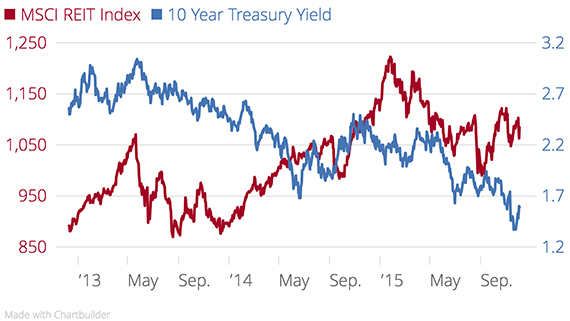Trending
Here’s why REIT stocks are on the rise
It’s all about the 10-year Treasury yield

Real estate investment trusts are back. After a tough start to the year, share prices of New York’s leading public real estate firms have climbed steadily for five months.
SL Green Realty [TRDataCustom], which reported second-quarter earnings last week, saw its stock jump 43 percent since early February. Vornado Realty Trust’s stock is up 30 percent from its February low, Boston Properties is up 28 percent and Brookfield Property Partners is up 26 percent. What’s behind the rally?
The “overwhelming driver,” according to John Kim, a REIT analyst at BMO Capital Markets, is the 10-year Treasury yield: Over the past three years, when the 10-year Treasury fell, REIT shares rose, and when the Treasury rose, REITs fell.
Low Treasury yields benefit REITs because they result in low interest rates across the economy. Cheap debt lowers REITs’ financing costs and increases overall demand for real estate, pushing up the value of their holdings.
As of Tuesday, afternoon, the 10-year Treasury yield had fallen to 1.56 percent, from 2.27 percent at the start of the year.
In last week’s earnings call, SL Green’s CEO Marc Holliday said he expects his firm to see an “extraordinary amount of savings” from low interest rates this year, in excess of the $30 to $40 million that had been anticipated. Meanwhile, low bond yields make real estate returns look more attractive in comparison, which attracts investors and adds another boost to property values.
“Real estate is a derivative of credit in the economy,” said Alexander Goldfarb, a REIT analyst at invesment bank Sandler O’Neill.
The interest-rate effect explains why stocks of New York-focused REITs rose so strongly in recent months, despite the fact that the current real estate cycle should be winding down after years of growth and even though recent market reports have painted a sobering picture.
It’s important to note that falling Treasury yields don’t always lead to rising REIT stocks. In late 2015, for example, both fell noticeably. The explanation: investors were worried that economic uncertainty (which drove down treasury yields) could also hit commercial real estate companies.
This time around, most investors appear to think that the impact of Britain’s vote to leave the European Union or Italy’s looming banking crisis won’t put a hurt on U.S. real estate companies.
“People Are Getting More Comfortable That Real Estate Is Not A Bad Place to be,” said Dirk Aulabaugh of Green Street Advisors.
The good news for REIT investors is that the Treasury yield could stay low for a while. In May, JPMorgan cut its yield forecast for the end of 2016 to 1.9 percent, from 2.15 percent. Goldfarb argued that even if the Federal Reserve raises short-term interest rates in September, the long-term Treasury yield is unlikely to spike.
“Long-term rates are set by the market, and the Fed has only so much impact on the market,” he said.
The bad news for REITs is that even after months of rising share prices, many still trade at a discount to the net asset values of their underlying properties, which could indicate investors are pessimistic about real estate prices. On weighted average, office REITs trade at an 8.3 percent discount to their underlying net asset values, according to BMO. Vornado (16.3 percent discount) and SL Green (19.4 percent) are even worse off. “It’s a combination of leasing slowing down while at the same time cap rates are moving up,” said BMO’s Kim, adding that some REITs are “highly levered.”
Apartment REITs are performing somewhat better, trading at an average discount of 1.9 percent, while healthcare REIT valuations exceed their underlying asset values by an average of 23.5 percent.




